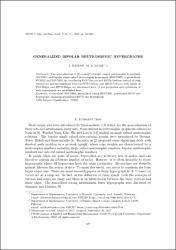Generalized bipolar neutrosophic hypergraphs
Citation
Hassan, A. & Malik, M. A. (2020). Generalized bipolar neutrosophic hypergraphs. TWMS Journal of Applied and Engineering Mathematics, 10(4), 827-845.Abstract
The generalization of the concept of single valued neutrosophic hypergraph (SVNHG) and bipolar single valued neutrosophic hypergraph (BSVNHG) to generalized SVNHG and BSVNHG by considering SVN-Vertices and BSVN-Vertices instead of crisp vertices set and interrelations between SVN-Vertices and BSVN-Vertices with family of SVN-Edges and BSVN-Edges are introduced here. A few properties and operations of such hypergraphs are established here.
Volume
10Issue
4URI
http://belgelik.isikun.edu.tr/xmlui/handle/iubelgelik/2883http://jaem.isikun.edu.tr/web/index.php/archive/108-vol10no4/595
Collections
The following license files are associated with this item:
Related items
Showing items related by title, author, creator and subject.
-
Generalized Hankel determinant for a general subclass of univalent functions
Yalçın, Sibel; Altınkaya, Şahsene; Owa, Shigeyoshi (Işık University Press, 2018)Making use of the generalized Hankel determinant, in this work, we consider a general subclass of univalent functions. Moreover, upper bounds are obtained for |a3 ? µa2 2|, where µ ? R. -
On generalization of weierstrass approximation theorem for a general class of polynomials and generating functions
Kumar, Hemant; Pathan, Mahmood Ahmad (Işık University Press, 2016)Here, in this work we present a generalization of the Weierstrass Approximation Theorem for a general class of polynomials. Then we generalize it for two variable continuous function F(x, t) and prove that on a rectangle ... -
Some results on generalized toeplitz operator on generalized hardy space
Al-Sharif, Sharifa; Jebreel, Yahya; Khanfer, Abdelrahman (Işık University Press, 2016)In this paper, we define and study some properties of the generalized Hardy space HF,2, where F is an injective linear transform from Lp (?) into Lp (?) and ? is the unit circle in the complex plane C. Also we introduce ...





